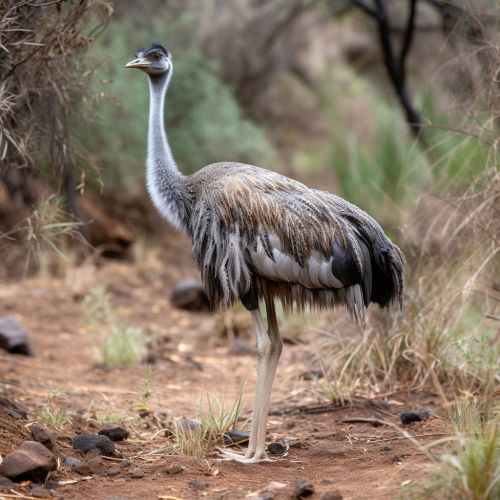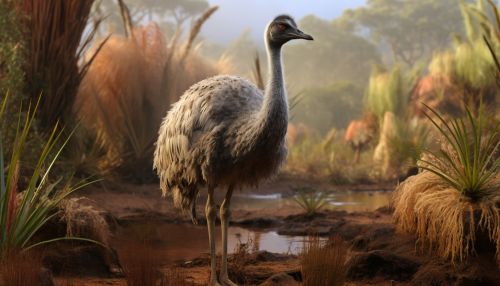Rhea
Taxonomy and Naming
The Rhea is a genus of flightless birds that are native to South America, belonging to the family Rheidae. The genus name "Rhea" was derived from the name of the Titan Rhea, a character from Greek mythology. The common name "rhea" is a reference to the bird's large size and flightless nature, which are similar to those of the ostrich and emu.
Description
Rheas are large, flightless birds with long legs and long, flexible necks. They are the largest birds in South America, with males reaching up to 1.5 meters in height and weighing up to 40 kilograms. Females are slightly smaller, typically reaching around 1.3 meters in height and weighing up to 35 kilograms. The feathers of the rhea are soft and fluffy, unlike the stiff, structured feathers of most birds. This is due to the absence of the tiny hooks that would typically hold the feathers in place. The color of their plumage varies from grey to brown, often with white spots, and is more pale on the underside.


Distribution and Habitat
Rheas are native to South America and can be found throughout Argentina, Bolivia, Brazil, Chile, Paraguay, Peru, and Uruguay. They inhabit a variety of environments, including grasslands, scrublands, and forests, but are most commonly found in open grasslands. Rheas are well-adapted to their environments, with their long legs allowing them to run quickly to escape predators and their sharp eyesight helping them spot threats from a distance.
Behavior
Rheas are diurnal birds, meaning they are active during the day and sleep at night. They are also known to be quite social, often forming flocks of up to 30 individuals. These flocks are usually made up of both males and females, although during the breeding season, males will establish territories and gather a harem of females. Rheas are known for their unique mating system, in which the male incubates the eggs and raises the chicks, while the females mate with multiple males and lay their eggs in the nests of different males.
Diet
Rheas are omnivorous, feeding on a variety of plants and animals. Their diet primarily consists of seeds, leaves, fruits, and roots, but they also eat insects, small mammals, and reptiles. They have a complex digestive system that allows them to extract nutrients from plant material, including cellulose, which many other animals cannot digest.
Conservation Status
The two species of rhea, the Greater Rhea and the Lesser Rhea, are both listed as Near Threatened by the International Union for Conservation of Nature (IUCN). Their populations have been declining due to habitat loss, hunting, and egg collection. Conservation efforts are currently underway to protect and preserve these unique birds.
